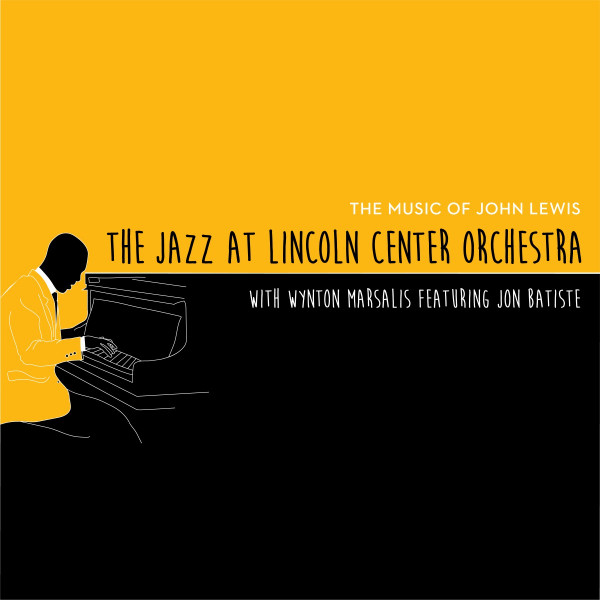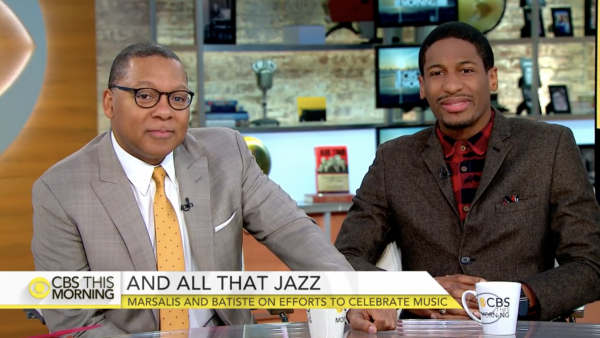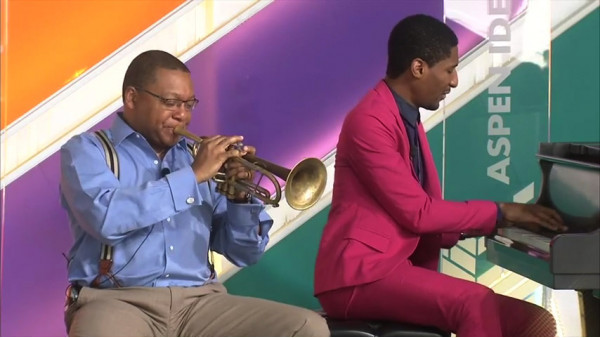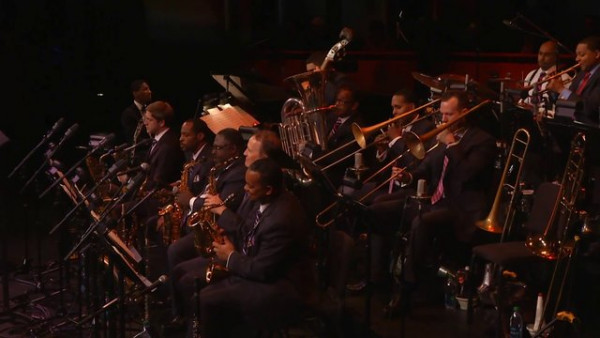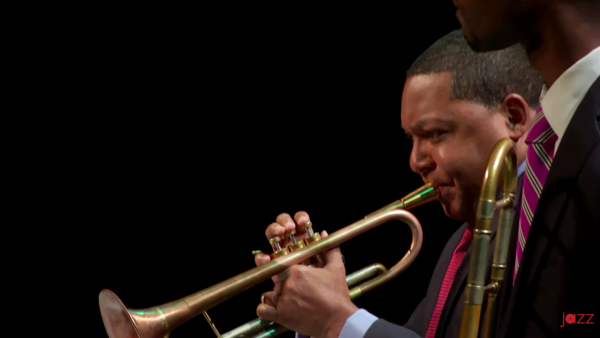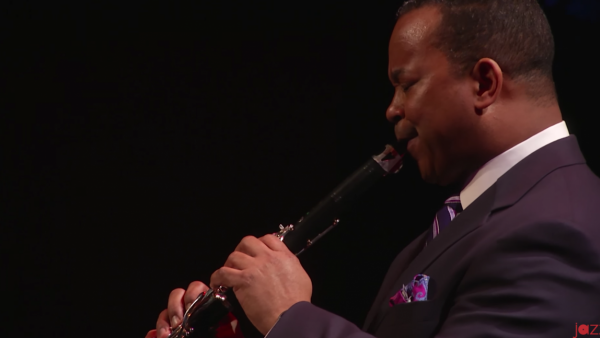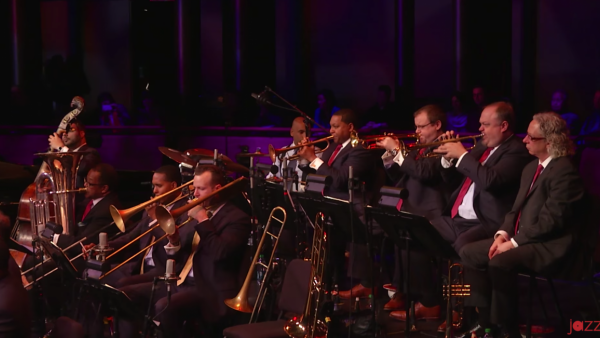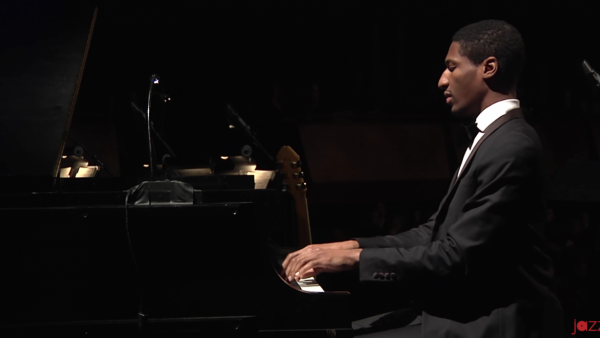Jon Batiste and Wynton Marsalis Prize John Lewis, and Each Other
By the time Jon Batiste arrived at Spotify’s studios near Union Square on a recent evening, the trumpeter Wynton Marsalis had commandeered his seat at the piano.
Mr. Batiste, who had hustled across town after taping that day’s episode of “The Late Show,” where he is Stephen Colbert’s musical foil, went around the room dapping and high-fiving the other band members as they rehearsed a blues. Then he stationed himself beside Mr. Marsalis, watching as the elder musician plunked out a playful solo.
It was a Monday in early March, and the two jazz luminaries — separated by a generation — were there with a handful of members of Mr. Marsalis’s Jazz at Lincoln Center Orchestra to record two bonus tracks for “The Music of John Lewis.” (The tracks will be available only on Spotify.) The album, which comes out on Friday, features a 16-piece configuration of the orchestra, with Mr. Batiste joining as a special guest.
Every tune and nearly all the arrangements were written by John Lewis, who died in 2001 and is best known as the pianist and musical director for the Modern Jazz Quartet. In the 1950s that group became one of the first jazz bands to play for concert-hall audiences around the world. Mr. Lewis wrote elegant, epigrammatic compositions that integrated the counterpoint of chamber music into a hard-bop framework. And as the new album testifies, his compact motifs and pithy, swinging approach hold up strikingly well in large-ensemble arrangements.
In the 1980s Mr. Marsalis led a bumper crop of young jazz traditionalists seeking to enshrine straight-ahead, early-to-mid-20th-century jazz in the American canon. Much of what they celebrated — aesthetic refinement; swing rhythm; sophisticated, blues-based improvising — was at the core of the Modern Jazz Quartet’s identity.
Mr. Batiste has emerged in the past two years, thanks to his role as the leader of “The Late Show” band, as one of the most visible jazz musicians of his generation. As such, both Lewis and Mr. Marsalis are beacons for him.
After the session, the two men found a quiet room off the studio to chat. Both come from esteemed musical families in New Orleans, and they have known each other since Mr. Batiste was a teenager. They discussed their hometown, Mr. Lewis’s influence and bringing jazz to the masses. These are edited excerpts from that conversation.
I know you two have a longstanding relationship. Jon, tell me how important Wynton Marsalis was to your development.
JON BATISTE Just the example he set, I came here at 17 to go to Juilliard, same as him. Seeing how he was able to create a path for himself, putting the music and his philosophy of the music and the vision of all his mentors — Albert Murray, Stanley Crouch — into an institution, and bringing that to life on the bandstand, and hundreds of records. It’s legendary, and he ain’t even done yet.
You both come from deep musical families. Wynton, did you know Jon when he was growing up?
WYNTON MARSALIS I knew his family. His family’s famous in New Orleans.
BATISTE I almost see our families as village elders. His dad, Ellis Marsalis; Alvin Batiste; Edward “Kidd” Jordan; Clyde Kerr. It seems like you’ve got four or five musicians who taught the last generations of musicians out of New Orleans. Forty years of musicians, and we’ve got the same elders. It’s almost like an oral tradition is passed down.
MARSALIS We’re from that tribe. And it was a struggle. I always want to make this clear about my father, James Black, Alvin Batiste: They struggled. They were like voices in the wilderness. So I represented them, and then when I would see Bat when he was a kid, 12 or 13, I can’t explain the love I had for him. Because we’re from that same tribe, and it’s familial, you know?
John Lewis had a special relationship with Lincoln Center. I’m sure he inspired a lot of the work that the orchestra continues to do.
MARSALIS I used to go to his house all the time. That was my man. We started to play duo gigs, just me and him. He was a man of tremendous dignity, intelligence. And he really prepared for concerts. He believed in music. It didn’t matter what the environment was.
The Modern Jazz Quartet started when John Lewis replaced Thelonious Monk in Dizzy Gillespie’s big band, and then its four members broke away to form their own group. Jon, to me, Monk and Lewis are two of the clearest influences on your style, even though their playing is so different. Can you talk about how both of them have influenced your playing?
BATISTE Logic. I think about the intensity of logic that John Lewis and Thelonious Monk played with. I actually went one year straight almost exclusively listening to Thelonious Monk. When I was 19 I discovered it, and it’s kind of like the feeling of building a computer, and then finding that somebody already built the computer that you’re envisioning building, but better. And they did it 30 years ago. So I had this idea of playing with a certain spatial awareness, and a balance in the rhythm, and remembering your themes and bringing things back in obtuse ways. Those are all elements of John Lewis and Thelonious Monk’s playing, in different ways.
Wynton, how can you describe the influence of the Modern Jazz Quartet on your work?
MARSALIS What Jon was saying: the spatial layout of the music, how he dealt with his thematic development. That’s the thing that’s most interesting. And how he created diversity. He liked diversity in dynamics, changes in keys. And he liked the soft dynamic. He’d say, “If you start off too loud, you can’t converse.” It’s much easier to cuss and scream than it is to converse. And when you see how democracy is breaking down now, you can see how. And I don’t mean just now. I mean, it’s been breaking down for the past 40 or 50 years.
That in large part is what he was talking about: the type of integrity required to maintain a dialogue with someone who does not think like you. And the type of integrity and discipline you have to have to look at another person whose point of view is the opposite of yours, and have the respect to hear them.
Even within that quartet’s members, you had that dynamic.
MARSALIS Yeah, him and Milt Jackson. Connie Kay, too.
Jon, your main job these days is on “The Late Show.” Are there ways in which you’re able to bring some of these ideas about what the music represents to your work on TV?
BATISTE Something that I think about all the time is the creative license that I’ve been given, to play a range of music — even if it’s just for five to 10 seconds. I think about, who are you playing for in the next generation? You’re exposing this music to people, 3 million, 4 million people at a time. You don’t know who’s listening. And you can make connections that might go over most people’s heads, but somebody out there is hearing it.
I did a few arrangements of Mozart’s “Requiem” recently. I played some of the Debussy piano preludes with a Mardi Gras Indian beat behind it. We play everything, man. It’s a range of music, because it’s a range of people who come through the show. It’s been remarkable to think about how much of the world I’m able to interact with and engage with. When you hear the stuff that we’re playing, it’s not traditional by any stretch. And I think it’s beautiful that they’re giving me the license to just do that, and supporting that.
by Giovanni Russonello
Source: The New York Times

